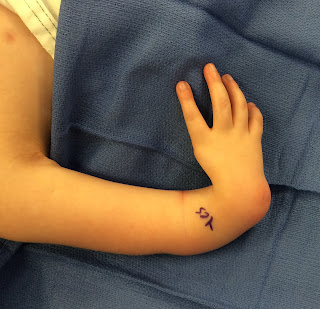Radial longitudinal deficiency is both a functional challenge and an appearance issue. Different surgeons have developed different strategies based on these challenges and the lack of a ‘perfect’ surgery. My philosophy is to consider different surgeries, based on the child. I will consider centralization (typically with a period of external fixator distraction prior to the centralization), a release with bilobed flap, or occasionally a lengthening of the radius. And, sometimes, even with a deficient radius, surgery on the wrist may not be helpful. The pollicization procedure is one of my favorites because it is so effective and so helpful.
This is a patient with a severe radial deficiency on the right (treated with external fixator, centralization, and pollicization). Note the 90 degree deformity of the wrist. The patient had a milder deficiency on the left (treated with pollicization). This is an image before surgery on the right.
 |
| Severe radial deficiency with the wrist at about 90 degrees from the forearm. Note the short forearm and the lack of a thumb. |
Here is an image of both hands after surgery on the left wrist (note how much straighter it is compared to the picture above) and the creation of both thumbs with pollicizations.
This first video gives some indication of the outcome of her pollicizations. Remember- the pollicization helps in a few major ways including fine pinch (such as beads, in this video) and larger object grasp (second video). The right hand and wrist were severely affected from birth and while she is doing well after surgery, she still has limitations. You can see how well her left hand and new left thumb work (after pollicization). However, on the right, the new thumb is not as strong or effective and she sometimes uses the ring and small fingers (called prehensile function). This may further change over time to favor use of the new thumb.
This next video demonstrates several important findings. First, the right side is weaker and she clearly, she prefers the left hand (which has only had the pollicization). The left side in general (and the left thumb in particular) is stronger and more stable. The right hand is helpful to her as is its pollicized digit BUT, when she really tries to use the right hand and the pollicized digit does not help, she switches to try the ring and small finger for grip (that is reflective of her prehensile grasp which never quite goes away).
I hope these videos are helpful in understanding outcome with severe radial deficiency.
Charles A. Goldfarb, MD
My Bio at Washington University
congenitalhand@wudosis.wustl.edu
